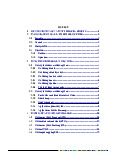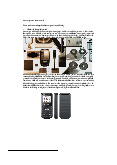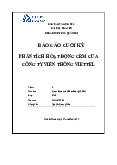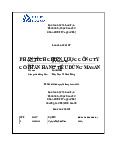



















Preview text:
LEADERSHIP CHAP 01 – PART 01
1. While _____ is an important aspect of leadership effectiveness, the key element is _____
A. goal achievement; stakeholder satisfaction B. empowerment; participation
C. leader style; providing direction
D. internal processes; outcome
2. An effective leader is someone who:
A. Focuses on politics and networking
B. Focuses in his/her own work, interests and promotion
C. Focuses on the works and achievements of his/her people, and takes care of them
D. Focuses on using position power
3. Which one of the following is not part of a general definition of leadership? A. interpersonal influence B. hierarchy C. exercise of control D. group phenomenon
4. Which one of the following factors is the key element of most definitions of leadership effectiveness? A. financial measures B. employee satisfaction C. stakeholder needs D. focus on outcome
5. The three key elements of leadership effectiveness are all except_______. A. flexibility B. external adaptability C. smooth internal processes D. goals achievement
6. The three key elements of leadership effectiveness are:
A. follower satisfaction, leader control, empowerment
B. flexibility, follower satisfaction, stakeholder satisfaction
C. goal achievement, stock prices, customer satisfaction
D. goal achievement, smooth internal processes, external adaptability
7. Barbara Waugh, a Civil Rights activist and worldwide change manager at Hewlett-Packard
Laboratories, defines leadership effectiveness as_____
A. meeting corporate objectives B. empowering employees
C. finding a story worth living
D. always making the customer happy
8. Which of the following statements is true about the definition of leadership effectiveness?
A. Leadership effectiveness must take into account the personality of the leader
B. Leadership effectiveness depends on the goals of the organization
C. Leadership effectiveness is the same regardless of the organization
D. Leadership effectiveness is always based on performance
9. Bill Gates, founder of Microsoft, considers which of the following to be key to leadership? A. articulating a vision B. setting goals
C. addressing the needs of stakeholders D. empowerment
10. According to Fred Luthans, effective managers focus on ________ while successful managers focus on ____
A. change management; employee satisfaction
B. stakeholders; goal achievement
C. employee satisfaction; quick promotions
D. goal achievement; stock prices
11. Which of the following factors is not part of the definitions of leadership effectiveness? A. follower satisfaction B. ability to change C. maintaining control D. achieving goals
12. Hùng, a salesperson for ABC, Inc., relies heavily on his supervisor to provide annual goals and
direction was well as to clarify activities for the upcoming year. Which reason for ‘why we need
leaders’ best fits this situation? A. to accomplish tasks B. to be romantic ideals C. to make sense of the world
D. to keep groups orderly and focused
13. Which one of the following is not one of the obstacles to effective leadership?
A. inaccessible academic research
B. uncertainty that creates pressure for quick responses
C. rigid and short-term oriented organizations
D. reliance on new ideas about organizational structure
14. Compared to leaders, managers do all of the following except______
A. implement policies and procedures B. maintain status quo
C. establish an emotional link with followers D. use position power
15. While leaders focus on ________, managers focus on _____
A. maintaining existing structure; here and now
B. initiating goals and strategies; implementing policies and procedures
C. personal relationships; willing to create change networks
D. using position power; sharing values
16. Managers are_____, while leaders are_____
A. long-term oriented; short-term oriented
B. short-term oriented; long-term oriented
C. making use of personal power; making use of positional power
D. interested in creating a culture based on values; interested in maintaining existing structure
17. Kip Tindell, founder of The Container Store, created a family-friendly work environment with
higher wages and flexible shifts. He may be considered an effective leader because _____ .
A. He created a culture on shared values
B. he only used position power to get things done
C. he was interested in maintaining the status quo
D. he focused entirely on the present
18. Leadership and management become more closely similar when considering the issue of_____
A. effectiveness and competence
B. national and organizational culture C. organizational performance. D. individual traits.
LEADERSHIP CHAP 01 – PART 02
1. Bob Landouceur, La Salle high-school football coach wants his team members to get in touch
with their emotions and develop ‘love’ for their teammates. Through this process he
demonstrates great empathy for his players. Which function of how leaders shape
organizational culture best describes Bob’s leadership style?
A. creating an effective organizational strategy and structure B. role modeling
C. creating an effective reward system D. hiring the right people
2. Leaders are often role models for their followers. Recent research suggests that leaders must also pay attention to.
A. sexual harassment and its negative impact B. the use of power
C. how outsiders impact their followers
D. their own emotional reactions
3. When leaders establish a highly decentralized structure, the result is likely to be a _________ culture. A. closed B. inflexible C. externally focus D. participative
4. Determining span of control, reporting relationships, and degree of formalization and
specialization are all elements of which function of how leaders shape organizational culture?
A. creating effective reward systems B. role modeling
C. developing strategies and structures
D. influencing hiring decisions
5. Lê Hoàng Minh is a senior executive of Medtronics, an organization dedicated to promoting
healthy lifestyles. Minh runs marathons and maintains a personal healthy lifestyle. Which
function of shaping an organizational culture best describes Minh’s approach? A. hiring the right people
B. creating an effective reward system C. being a role model
D. creating an effective organizational strategy and structure
6. Which of the following is not one of the managerial roles proposed by Mintzberg? A. leader B. conflict manager C. resource allocator D. figurehead
7. Leaders could shape the organizational culture by all except ______. A. position power B. vision and mission C. hiring decision D. role modeling
8. Helgesen’s research found that female managers only matched how many of Mintzberg’s categories of executive roles? A. two B. five C. one D. four
9. Thuy Trang, senior vice president of sales for Secure Works, takes an approach whereby
employees “make your numbers in three months or run the risk of being put on probation, and
then possibly termination.” Through this process he measures employee performance, provides
detailed feedback and training to improve sales. Which function of how leaders shape
organizational culture best describes Trang’s approach?
A. creating an effective organizational strategy and structure B. hiring the right people C. role modeling
D. creating an effective reward system
10. In addition to basic managerial functions of planning, organizing, staffing, directing, and
controlling, leaders are ascribed_________.
A. strategic and external roles
B. strategic and internal roles
C. procedural and external roles
D. procedural and internal roles
11. If the founder of the organization is a workaholic and control oriented, the organization is likely to be characterized as:
A. participative and supportive
B. fast-paced decision making and centralized
C. 'the web’ whereby the manager is in the center of an interconnected circle
C. decentralized and open
12. In traditional organizations, employees are primarily responsible for ________ while leaders are responsible for ________. A. production; planning B.controlling; quality C. preparing; implementing D. planning; controlling
13. According to the textbook, which country has a high percentage of women (about 23%) in corporate boards? A. Sweden B. France C. Japan D. United States
14. The factors that are pushing for new roles for leaders include all but one of the following: A. use of teams B.push for quality C.changing hierarchies
D. increased homogeneity
15. The younger employees who are joining the workforce typically expect to________.
A. stay with the same company for over ten years
B. have autonomy and participate in decisions
C. be promoted slower than previous generations
D. receive life-time employment from the same company
16. Factors fueling changes in organizations and their leaderships are:
A. Changes in demography and people’ life-styles.
B. Increased global and local competitions, specially in technology.
C. Worldwide political changes. D. All of the above.
17. The challenges arising from issues regarding the differences in age groups represents which
major factor fueling organizational change and their leaders? A. increased globalization B. demographic changes C. political changes D. employee expectations
18. ________ is/are barriers to changes in organizations and leaders.
A. Lack of teams in upper management
B. Open structures and ill-defined goals C. Global cultural changes D. The focus on team rewards
19. The increased cultural diversity in organizations is____
A. causing most leaders to become ineffective
B. leading to higher salaries across the board
C. leading to conflict between leaders and followers
D. causing changes in organizational practices
20. Changes in many organizations are causing leaders to rely more on ______ and less on _____ A. vision; consideration
B. facilitation; structuring C. consideration; task D. planning; leading
21. In a results oriented organization that focuses on quality and teamwork, which level of
organizational structure should assume primary responsibility? A. senior executives B. front line supervisors C. mid-level managers D. employees
22. Which of the following are not some of the factors that are fueling the changes in leadership?
A. demographic and social changes B. political changes
C. increase in global competition D. legal requirements
LEADERSHIP CHAP 02 – PART 1
1. _____refers to the variety of human structures, belief systems, and strategies for adapting to
situations that exist within different groups. A. Masculinity B. Gender C. Leadership D. Diversity
2. Apple’s highly demanding work environment has been attributed to: A. the national culture
B. the lack of challenging, performance expectations
C. Steve Job’s ethical behavior
D. the culture of the organization
3. People who live in the ‘Little Saigonl’ region of California state have maintained Vietnamese
traditions, norms and customs from generation to generation. This is an example of what level of culture? A. National B. Global C. Organization D. Group
4. ________is the norms, customs, values, and assumptions that guide the behavior of a particular group of people. A. Leadership B. Collectivism C. Culture D. Diversity
5. Larry Page, co-founder of Google, created an organizational culture that:
A. took into consideration the employees’ job satisfaction
B. rewarded top financial performance
C. separated personal and organizational goals
D. allowed for excellent financial performance
6. A U.S. manager who is negotiating in China has difficulty getting his Chinese counterparts to
agree to put the details of their new contract on paper. At the same time, the Chinese managers
are frustrated at the U.S. manager’s insistence to clarify every detail. This conflict is can be
partially attributed to__________:
A. the differences in the two countries political systems
B. the difference in how the two cultures use context
C. the U.S. superiority in business interactions
D. the Chinese not trusting the U.S. manager
7. Leaders in high-context cultures may interpret the low-context followers’ directness as _______.
A. a sign of a valuable employee
B. an indication of effective leadership C. a display of respect D. a lack of respect
8. The High and Low Context model of culture addresses: A. different cultural values
B. the organizational cultural context
C. differences in leadership patterns
D. differences in communication styles
9. According to Hall’s theory, people from low context cultures typically:
A. Value leaders who focus on tasks.
B. Value leaders who are friendly and take care of people.
C. Rely on non-verbal cues, status, unstated expectations and trust.
D. Rely on the written word, clearly stated statement and formal contracts.
10. People from low context cultures typically:
A. value leaders who focus on the task
B. rely on the written word and clearly stated statement to communicate
C. rely on non-verbal cues and situational factors to communicate
D. value leaders who take care of people
11. Which of the following cultures is NOT considered a high-context culture? A. Scandinavian B. Korea C. Japanese D. China
12. Tolerance of uncertainty refers to:
A. the extent to which employees rely on their manager for decision making
B. how comfortable people are with ambiguity
C. how much uncertainty exists in the political system
D. how quickly managers make decision
13. Leaders from individualistic cultures would best be characterized by_______
A. employing supportive leader behaviors B. seeking recognition
C. engaging in team-oriented activities
D. demonstrating high levels of participation behaviors
14. By Hofstede,__________power distance indicates that employees would generally accept
work assignments from their supervisors without question, whereas a __________power
distance indicates that employees generally have about the same amount of power as their boss. A. Low; high B. Low; low C. High; high D. High; low
15. When a culture is high in uncertainty avoidance, people are likely to:
A. rely on their community for information
B. have a short term orientation
C. search for absolute truths
D. expect their leaders to allow participation
16. Which of the following is NOT one of Hofstede’s five dimensions of culture? A. Individualism B. People orientation C. Time orientation D. Uncertainty avoidance
17. Harry Triandis proposes that the concept of Hofstede' uncertainty avoidance dimension can be further refined by:
A. looking at how uncertainty avoidance is different in vertical and horizontal cultures
B. adding the concept of time orientation to tolerance for uncertainty.
C. combining context and individuality to explain uncertainty avoidance.
D. introducing the concept of tight and loose cultures to uncertainty avoidance.
18. Which best describes a country characterized with a high power distance?
A. there is a free flow of communication between leaders and followers B. hierarchy
C. communication is typically directed only one way
D. feedback is expected from followers
19. The concept of individualism/collectivism can be further refined by considering___________:
A. whether followers make decisions on their own
B. how tight or loose the culture is.
C. the concept of vertical and horizontal cultures



